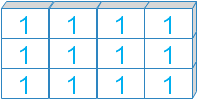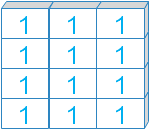Numpy reshape()
numpy.reshape(a, newshape, order='C')a | array input |
newshape | New shape for the original array. Integer for 1-D array, tuple for multi Dimensional. |
order | {‘C’, ‘F’, ‘A’}, optional |
 |  |
| Shape: (3, 4) Dimension 2 | Shape: (4, 3) Dimension 2 |
- While reshaping data of the original array will not be lost.
- The reshape array must be compatible with original shape , otherwise value error will be raised.
Along with shape() we will display the dimension of the array by using ndim
One dimensional array
import numpy as np
ar=np.ones((6,))
print(ar)
print("Shape: ", ar.shape)
print("Dimension ", ar.ndim)
ar=ar.reshape((2,3))
print("##After using reshpae()##")
print(ar)
print("Shape: ", ar.shape)
print("Dimension ", ar.ndim)[1. 1. 1. 1. 1. 1.]
Shape: (6,)
Dimension 1
##After using reshpae()##
[[1. 1. 1.]
[1. 1. 1.]]
Shape: (2, 3)
Dimension 2Two dimensional array
import numpy as np
ar=np.ones((3,2))
print(ar)
print("Shape: ", ar.shape)
print("Dimension ", ar.ndim)
ar=ar.reshape((2,3))
print("##After using reshpae()##")
print(ar)
print("Shape: ", ar.shape)
print("Dimension ", ar.ndim)[[1. 1.]
[1. 1.]
[1. 1.]]
Shape: (3, 2)
Dimension 2
##After using reshpae()##
[[1. 1. 1.]
[1. 1. 1.]]
Shape: (2, 3)
Dimension 2Three dimensional array
import numpy as np
ar=np.ones((3,2,3))
print(ar)
print("Shape: ", ar.shape)
print("Dimension ", ar.ndim)
ar=ar.reshape((2,3,3))
print("##After using reshpae()##")
print(ar)
print("Shape: ", ar.shape)
print("Dimension ", ar.ndim)[[[1. 1. 1.]
[1. 1. 1.]]
[[1. 1. 1.]
[1. 1. 1.]]
[[1. 1. 1.]
[1. 1. 1.]]]
Shape: (3, 2, 3)
Dimension 3
##After using reshpae()##
[[[1. 1. 1.]
[1. 1. 1.]
[1. 1. 1.]]
[[1. 1. 1.]
[1. 1. 1.]
[1. 1. 1.]]]
Shape: (2, 3, 3)
Dimension 3Four dimensional array
import numpy as np
ar=np.ones((3,2,3,4))
print(ar)
print("Shape: ", ar.shape)
print("Dimension ", ar.ndim)
ar=ar.reshape((9,8))
print("##After using reshpae()##")
print(ar)
print("Shape: ", ar.shape)
print("Dimension ", ar.ndim)[[[[1. 1. 1. 1.]
[1. 1. 1. 1.]
[1. 1. 1. 1.]]
[[1. 1. 1. 1.]
[1. 1. 1. 1.]
[1. 1. 1. 1.]]]
[[[1. 1. 1. 1.]
[1. 1. 1. 1.]
[1. 1. 1. 1.]]
[[1. 1. 1. 1.]
[1. 1. 1. 1.]
[1. 1. 1. 1.]]]
[[[1. 1. 1. 1.]
[1. 1. 1. 1.]
[1. 1. 1. 1.]]
[[1. 1. 1. 1.]
[1. 1. 1. 1.]
[1. 1. 1. 1.]]]]
Shape: (3, 2, 3, 4)
Dimension 4
##After using reshpae()##
[[1. 1. 1. 1. 1. 1. 1. 1.]
[1. 1. 1. 1. 1. 1. 1. 1.]
[1. 1. 1. 1. 1. 1. 1. 1.]
[1. 1. 1. 1. 1. 1. 1. 1.]
[1. 1. 1. 1. 1. 1. 1. 1.]
[1. 1. 1. 1. 1. 1. 1. 1.]
[1. 1. 1. 1. 1. 1. 1. 1.]
[1. 1. 1. 1. 1. 1. 1. 1.]
[1. 1. 1. 1. 1. 1. 1. 1.]]
Shape: (9, 8)
Dimension 2
Subhendu Mohapatra
Author
🎥 Join me live on YouTubePassionate about coding and teaching, I publish practical tutorials on PHP, Python, JavaScript, SQL, and web development. My goal is to make learning simple, engaging, and project‑oriented with real examples and source code.
Subscribe to our YouTube Channel here
This article is written by plus2net.com team.
https://www.plus2net.com

 Python Video Tutorials
Python Video Tutorials